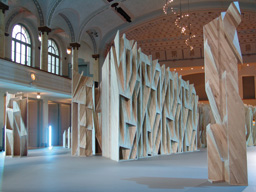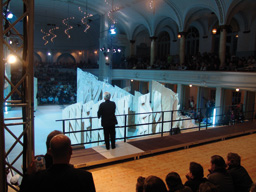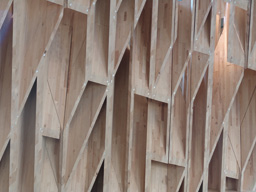|
designtoproduction • profile • team • awards and publications • how to find us | |||||

|


|
||||
|
Libeskind's Futuropolis Wooden sculpture 2005 Awarded with the Holz21 Prize 2005 Client University of St. Gallen (HSG) Holm Keller and Dr. Timon Beyes Design Studio Daniel Libeskind New York Daniel Libeskind and Thore Garbers Geometry Consulting and Engineering caad.designtoproduction ETH Zürich Christoph Schindler, Fabian Scheurer, Markus Braach CNC-Production Bach Heiden AG Heiden (CH) Franz Roman Bach, Hansueli Dumelin << back |
"Futuropolis" is a wooden sculpture designed by New York architect Daniel Libeskind for a workshop he held at the University of St. Gallen (HSG) in October 2005. HSG, a renowned business school, introduces its new students with a freshman week every year. In 2005 the aim of the 5-day workshop was to conceptualize a "City of the future" and visualize the ideas by help of the complex formed towers of the Futuropolis sculpture. The design is based on a triangular grid, where a 98 tightly packed towers form an ascending volume of up to 3.8 metres height. The towers are built from roughly 600 wooden boards that are intersecting the sculpture at an angle of 25 degrees and show the same pattern as the footprints of the towers. Thus, the boards are cut into almost 2000 wooden polygons by the perpendicular faces of the towers. To realise this design within the given time and budget was not possible by means of traditional craftsmanship, so a complete digital production chain was set up. The first challenge was to find an appropriate construction method to connect the boards of each tower so that maximum structural integrity could be guaranteed at minimum production and assembly costs. By using aluminium dovetail-connectors, the number of connection details could be reduced to only six variants with eleven subtypes, whose mitres and notches can be milled by a CNC-router. The second challenge was to generate the exact geometry of all 2164 parts, including the bases where the towers stand on. A completely parameterised CAD-model of the sculpture was programmed in Vectorworks, which calculated the outline of all parts by closely following the algorithmic design rules given by the architect. The appropriate connection details where automatically assigned to the edges, the parts were numbered and arranged on boards. The third step was to translate this geometry information into the steering code for the CNC-machine. Since the boards had to be turned around in the middle of the production process, two G-Code programs per board had to be generated by a script. Also the exact widths and lengths for calculating the material costs and for preparing the raw boards were automatically exported as data-tables. The sculpture consists of 360 square metres of 32 mm thick boards, altogether almost 11.5 cubic metres of birch wood. Total milling time summed up to about 200 hours, the assembly took roughly 500 man-hours. |
||||
|
Revision r1.14 - 20 Aug 2006 - 11:56 - ChristophSchindler Parents: WebHome |
|